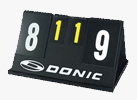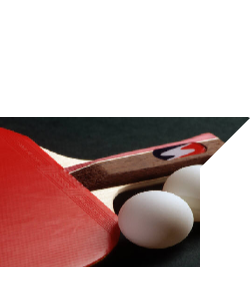
Scoring
The player, or doubles team, who first scores 21 points wins the game. However, you must win by two points so a game could go on to 30-50 points before being decided. A match is usually the best two out of three games, and in international championships, it is best three out of five games. In other words, if you lose the first game it’s not the end of the world; winning the next games can make you the winner.
Choice of Ends and Service
Who starts serving and which player gets to stand at which end? You can flip a coin... if you win the flip you can choose to SERVE or RECEIVE from the end you like. After each game you will alternate the ends. Should there be a tie, for instance, one game to one game, the players will change ends after the first player reaches 10 points in the final game.
The Serve
Stand behind your end of the table. Hold the ball in the palm of your free hand and throw the ball straight up in the air. As the ball falls, hit it so it lands on your half of the table, makes one bounce, and lands on the other side of the table. If the serve touches the net, it is a let, and you must serve again. If it touches the net and lands on the floor, you lose a point. If the serve goes into the net, you lose the point.
You serve until five points have been scored, and then the other player gets to serve for the next five points. At 20 to 20 (you must win by two points), you alternate the serve after each point.
The Server
The server is the player who starts the game by being the first to put the ball into play.
The Receiver
The receiver is the player who receives the ball from the server and returns it over the net. If you are the receiver, remember: The ball must not bounce twice on your side of the table and you can hit the ball only once to return it.Try to hit the ball on its highest peak and you will have a better angle hitting it back onto the opponent’s side.If your return touches the net and goes over, it’s okay. If it goes into the net, it is bad news! You lose a point. If your return goes over the net but misses the table, bad news again! You lose another point. Should your returning ball touch the edge of the table on your opponent’s side, that’s great! It’s very hard to return an edge ball. As long as the ball hits the edge while dropping, it counts. Should the ball hit the side of the table top, it is not considered an edge ball and will not count.
Win a Point
If the opponent fails to return your shot. Your shot can hit the boundary lines (white lines) on your opponent’s side or even the edge of the table and it is legal. Your serve can also hit the edge and it is legal.If you hit the ball off the table but it lands on you opponent’s paddle before it touches the floor or wall. This may seem odd that you can win a point by missing the table, but this rule is to prevent any volley play.
Lose a Point
If when attempting to serve or make a return, you miss the ball.
If you hit the ball into the net, including the top of the net, and it comes back to your side of the table.
If you hit the ball wide or too far so the first bounce hits the floor or the wall.
If you hit the ball before it bounces on your side of the table. No volley is allowed.
If the ball bounces twice on your side of the table before hitting it.
If you move the table or touch the net during play.
Legal Point
It is legal to hit the ball around the side of the net to land the ball on your opponent’s side.




